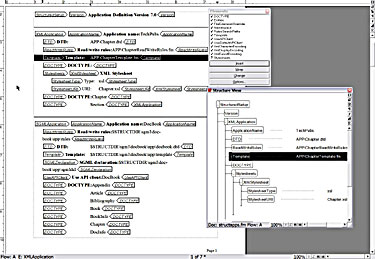framemaker sgml?
SGML (Standard Generalized Markup Language) is a system for organizing documents by specifying rules for tagging content elements, for example, body text, heads, and footnotes. HTML (HyperText Markup Language) and XML (eXtensible Markup Language), both languages used for creating Web pages, are subsets of SGML.
A tag is nothing more than a command placed inside a text document that specifies how an element should be formatted. The tags contain no formatting information -- the user is free to create any format definition for any tag. When such a text file is read, or interpreted by software such as a Web browser, the material is presented according to the formats defined within the file. For example, when the browser sees an H1 tag, it looks up the formatting specifications for H1 (let's say 20-point Arial) and then displays the element accordingly.
SGML also lets you specify rules, for example, that an H1 tag is always followed by body text or a List tag cannot contain an H1 tag. These rules are contained in file called a DTD (Document Type Definition) and assure that the final document will be uniform, regardless of who is editing or authoring the content. SGML is used to organize, or structure long documents whose sections may be written by different authors, are frequently revised, and are output in assorted formats (print and Web, for example). The advantage of an SGML structured document is that the structure and format specifications are built-in, so no matter how many people work on the project, the organization of material and appearance remain consistent. Needless to say, SGML is popular with companies that build complex machines that need extensive documentation written by hordes of engineers. As a result it operates on Unix as well as Windows and Mac operating systems.
FrameMaker imports and exports both SGML or XML structured documents and includes a standard set of structured templates for common publishing tasks. These templates include the element definitions required to produce consistent structured documents (see Figure 1).

Comments
 English
English


 Bulgarian
Bulgarian
